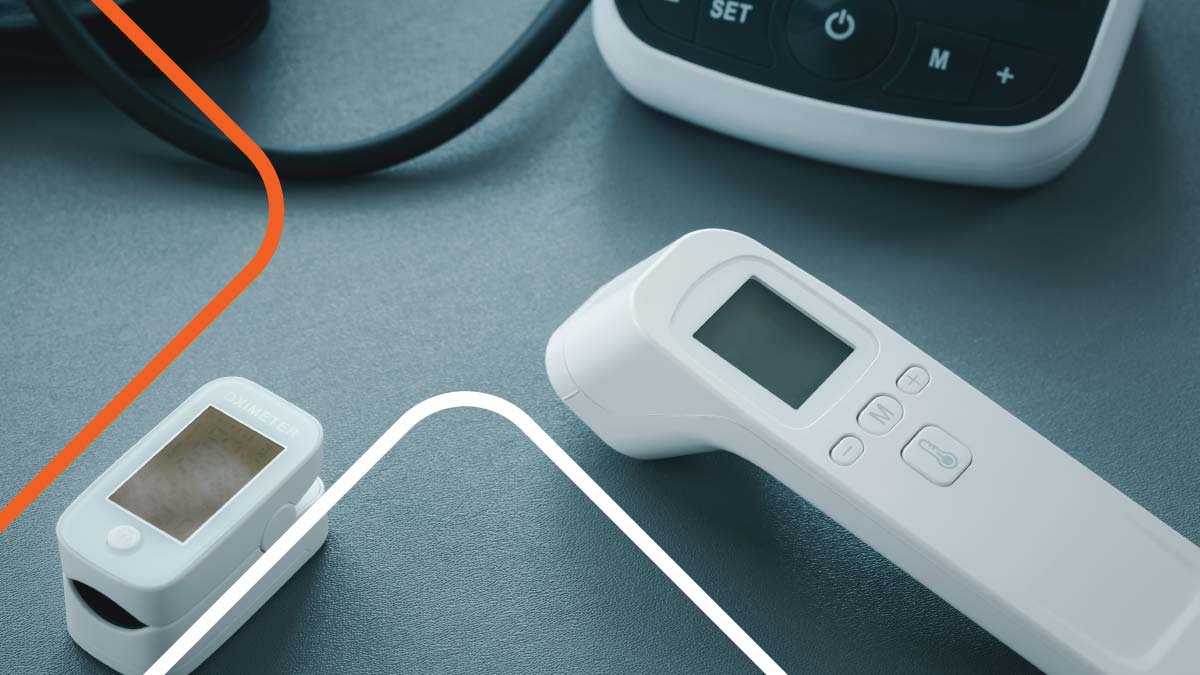The Internet of Medical Things (IoMT) has revolutionized the healthcare industry, bringing a new era of interconnected medical devices and advanced healthcare systems. In this article, we will explore the concept of IoMT, its key components, its role in modern healthcare, the technology behind IoMT devices, future trends, and the challenges and solutions in IoMT implementation.
Defining the Internet of Medical Things (IoMT)
The IoMT refers to a network of interconnected medical devices and applications that can collect, transmit, and analyze data to improve patient care and streamline healthcare operations. It encompasses many devices, including wearable sensors, remote monitoring devices, implantable devices, and mobile health applications.

The concept of IoMT
The concept behind IoMT is to create a seamless flow of information between medical devices, healthcare providers, and patients, enabling real-time monitoring, analysis, and decision-making. By connecting these devices and applications, healthcare professionals can access vital patient data, gain insights into patient health trends, and deliver personalized, efficient, and timely care.
Key components of IoMT
Several key components make up the IoMT ecosystem:
- Sensors and devices: These are the physical devices that collect and monitor patient data, such as heart rate, blood pressure, glucose levels, and more.
- Connectivity: The devices are connected to the cloud through various communication technologies, such as Wi-Fi, Bluetooth, and cellular networks.
- Data storage: The collected data is securely stored in electronic health record (EHR) systems or cloud-based platforms for easy access and analysis.
- Analytics and artificial intelligence (AI): Advanced analytics and AI algorithms analyze the collected data and generate meaningful insights to aid in diagnosis, treatment, planning, and predicting health outcomes.
One of the key advantages of IoMT is its ability to revolutionize remote patient monitoring. With wearable sensors and remote monitoring devices, healthcare providers can closely monitor patients’ health conditions even when they are not physically present in the hospital or clinic. This allows for early detection of abnormalities or changes in patient’s vital signs, promoting timely intervention and preventing potential complications.
Moreover, IoMT has the potential to greatly enhance the efficiency of healthcare operations. Healthcare providers can save time and resources by automating data collection and analysis. For example, instead of manually recording patients’ vital signs, which can be time-consuming and prone to errors, IoMT devices automatically transmits the data to the healthcare provider’s system, eliminating manual data entry and reducing the risk of inaccuracies.
The role of IoMT in modern healthcare
The IoMT has the potential to revolutionize modern healthcare by leveraging interconnected devices to enhance patient care and streamline healthcare operations.
One key benefit of IoMT is its ability to provide continuous and remote monitoring of patients. This allows healthcare providers to detect potential health issues early and intervene promptly. This real-time monitoring improves patient outcomes and reduces the need for frequent hospital visits, enhancing overall quality of care.

Enhancing patient care
With IoMT devices, healthcare providers can remotely monitor patients for early detection of potential health issues and timely interventions. Patients can also actively participate in their care by accessing real-time health data through mobile apps and wearables, empowering them to make informed decisions about their health and wellness.
Furthermore, IoMT facilitates personalized medicine by collecting vast patient data and leveraging artificial intelligence algorithms to analyze this information. This data-driven approach allows healthcare professionals to tailor treatment plans to individual patients, leading to more effective and targeted care.
Streamlining healthcare operations
IoMT devices streamline healthcare operations by automating manual processes, reducing administrative burden, and improving efficiency. For example, inventory management systems can automatically track medical supplies, ensuring hospitals have the necessary equipment and reducing waste. Additionally, telemedicine platforms enable remote consultations, saving patients and healthcare providers time and resources.
Moreover, IoMT plays a crucial role in preventive care through the continuous monitoring of vital signs and health parameters. By analyzing this data in real time, healthcare providers can identify patterns and trends that may indicate potential health risks, allowing for early intervention and preventive measures.
The technology behind IoMT devices
IoMT devices rely on advanced technologies to enable seamless connectivity and data transmission while addressing security and privacy concerns.
IoMT devices represent a groundbreaking fusion of healthcare and technology, revolutionizing patient care and monitoring. These devices have sensors and connectivity features that support real-time data collection and analysis, leading to more personalized and efficient healthcare services.
Connectivity and data transmission
IoMT devices transmit data using various communication technologies. Wi-Fi and Bluetooth are commonly used for short-range communications, while cellular networks provide wide-area coverage. These devices also leverage cloud computing technology, allowing the storage and analysis of vast amounts of data. Secure data protocols and encryption techniques protect the privacy and integrity of patient information.
Furthermore, IoMT devices often incorporate edge computing capabilities, enabling data processing to occur closer to the source. This reduces latency and enhances real-time monitoring, which is crucial for applications such as remote patient monitoring and emergency response systems. By harnessing the power of edge computing, IoMT devices can deliver rapid insights and responses, improving overall patient outcomes.
Security and privacy concerns
As the IoMT ecosystem expands, security and privacy concerns come to the forefront. Protecting patient data from unauthorized access and ensuring the devices’ integrity is critical. Manufacturers must embed robust security measures, such as encryption and authentication protocols, in IoMT devices. Healthcare organizations must also implement strict data privacy policies and adhere to regulatory requirements, such as HIPAA.
In addition to encryption and authentication, IoMT devices increasingly adopt blockchain technology to enhance security. Blockchain provides a decentralized and tamper-proof system for storing sensitive data, reducing the risk of data breaches and supporting the traceability of information exchanges. This added layer of security instills trust in patients and healthcare providers, fostering the widespread adoption of IoMT devices in the ever-evolving landscape of digital healthcare.
Future trends in IoMT
The development of IoMT technology is rapidly progressing, with several exciting trends on the horizon.
As IoMT continues to evolve, one key trend to watch out for is the integration of blockchain technology. Blockchain enhances the security and privacy of patient data, protecting sensitive information from cyber threats. Using blockchain in IoMT devices and systems allows healthcare providers to establish a secure and transparent network for data exchange, ultimately improving trust between patients and healthcare professionals.
Predicted developments in IoMT technology
Advancements in wearable sensors, miniaturization of devices, and improvements in connectivity will continue to shape the future of IoMT. We can anticipate the emergence of more sophisticated devices capable of detecting and monitoring a wider range of biomarkers. Machine learning and AI algorithms will become increasingly popular for real-time analysis and decision support.
Another exciting development in IoMT technology is the rise of edge computing. By processing data closer to the point of care, edge computing reduces latency and enhances the speed of data analysis in IoMT systems. This real-time processing capability is essential for applications that require immediate insights, such as remote patient monitoring and emergency response systems.
The impact of IoMT on the healthcare industry
IoMT has the potential to transform the healthcare industry. It empowers patients, improves healthcare outcomes, reduces costs, and enhances patient experience. By enabling personalized medicine, early detection of diseases, and optimized healthcare delivery, IoMT has the power to revolutionize healthcare.
Furthermore, adopting IoMT can lead to significant advancements in preventive care. By continuously monitoring vital signs and health metrics, IoMT devices can help individuals take proactive measures to maintain their well-being and prevent the onset of chronic conditions. This shift towards preventive healthcare benefits individuals by promoting healthier lifestyles and eases the burden on healthcare systems by reducing the prevalence of preventable diseases.
Challenges and solutions in IoMT implementation
While IoMT offers immense potential, some challenges must be addressed for a successful implementation.
One significant challenge in IoMT implementation is data privacy and security. With the vast amount of sensitive patient data being collected and transmitted through IoMT devices, there is a critical need to establish robust security measures. This includes implementing end-to-end encryption, multi-factor authentication, and access control mechanisms to safeguard patient information from potential cyber threats and unauthorized access.
Addressing IoMT security issues
Securing IoMT devices and the sensitive patient data they collect is of utmost importance. It requires a comprehensive approach that includes device-level security features, network security measures, and robust data encryption protocols. Regular security audits and patches must be implemented to detect and mitigate vulnerabilities.
Furthermore, healthcare organizations must prioritize cybersecurity training and awareness programs for staff members to ensure that proper security protocols are always followed. By fostering a culture of cybersecurity vigilance, healthcare providers can mitigate the risks associated with IoMT implementation and protect patient data from potential breaches.
Overcoming interoperability challenges
Interoperability among different IoMT devices and platforms remains a challenge. Standardization of data formats and protocols is necessary for seamless integration and communication between devices manufactured by different vendors. Collaborative efforts between manufacturers, healthcare organizations, and regulatory bodies are essential to overcome these interoperability challenges.
Moreover, integrating artificial intelligence (AI) and machine learning algorithms in IoMT systems can streamline data exchange and interoperability by automatically translating and interpreting data from diverse sources. By harnessing the power of AI, healthcare providers can enhance the efficiency and accuracy of IoMT systems, ultimately improving patient outcomes and clinical decision-making processes.
As IoMT continues to evolve, collaboration among stakeholders will play a crucial role in fostering its growth and harnessing its potential. By addressing security concerns, promoting interoperability, and staying abreast of technological advancements, the healthcare industry can fully leverage the power of IoMT to improve patient care and revolutionize healthcare delivery.
Conclusion
The IoMT has transformed the healthcare landscape, opening up a world of possibilities for enhanced patient care and streamlined healthcare operations. By connecting medical devices, analyzing data, and leveraging advanced technologies, IoMT empowers healthcare providers and patients alike.
However, addressing security concerns and overcoming interoperability challenges are key to the successful implementation of IoMT. With continued innovation and collaboration, IoMT has the potential to revolutionize healthcare and improve outcomes for patients worldwide.
Ready to enhance your IT operations? Take the first step by scheduling an introductory call with Field Nation today. Discover why we’re the leading solution for connecting with a vast network of skilled IT field service technicians.







